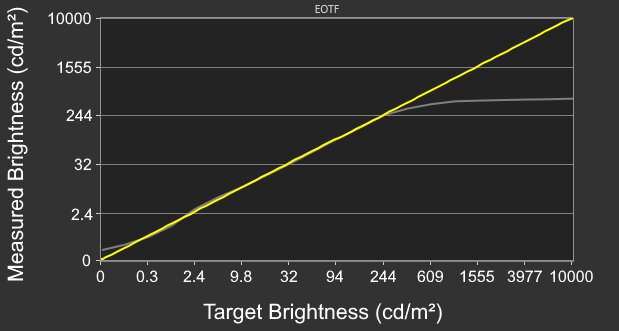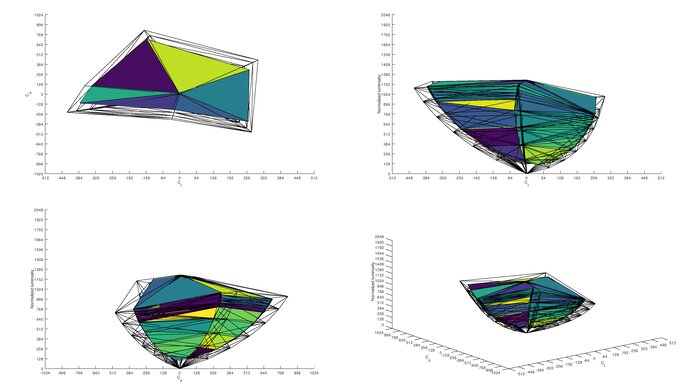The Dell UltraSharp U2720Q is a good 4k monitor that comes with HDR support and wide connectivity options. Like its predecessor, the Dell U2718Q, it features an IPS panel with good viewing angles, allowing you to easily share your work with colleagues. Images and text look sharp due to its high resolution, and its 27 inch screen provides plenty of space for multitasking. If you want to do some gaming on the side, it has a good response time and low input lag, however, there's no VRR support of any kind. On the bright side, its ergonomics are excellent and its USB-C input supports DisplayPort Alt Mode.
Our Verdict
The Dell UltraSharp U2720Q is a good monitor for most uses. It's a great choice for any productivity task, as it provides enough screen real estate to have multiple windows opened simultaneously, and its 4k resolution makes text and images look incredibly sharp. Its input lag is low and response time is good, but it doesn't support any variable refresh rate technologies. It has impressive coverage of the Adobe RGB color space for content creators, although you may want to calibrate the monitor first, as its out-of-the-box color accuracy is only decent.
- Excellent ergonomics.
- Good viewing angles.
- HDR support.
- No VRR support.
- HDR local dimming feature is terrible.
The Dell U2720Q is a great office monitor. Its 27 inch screen is great for multitasking and text looks sharp with its 4k resolution. You can easily adjust the screen to your optimal viewing position thanks to its excellent ergonomics, and it has an IPS panel that provides wide viewing angles, which is great when you need to share your work with coworkers. It should perform well in most rooms, although it's not recommended for very bright rooms with a lot of light shining directly on the screen, as its reflection handling is mediocre.
- Excellent ergonomics.
- Good viewing angles.
- HDR local dimming feature is terrible.
The Dell U2720Q is a good monitor for gaming. It has low input lag and its response time is good, but its refresh rate is limited to 60Hz and it doesn't support any variable refresh rate technologies. It's not the most ideal for dark room gaming, as it has a low contrast ratio that makes blacks look grayish. On the upside, the monitor's 4k resolution and large screen size are great for atmospheric or RPG games, as it's able to bring out every little detail in your game for an immersive gaming experience.
- Good viewing angles.
- 60Hz refresh rate.
- HDR local dimming feature is terrible.
The Dell U2720Q is a good monitor for media consumption. It has an excellent resolution and screen size to provide great immersion, and its wide viewing angles let you share content with others. Gray uniformity is excellent, as there's very little dirty screen effect, but black uniformity is only passable and its IPS panel has a low contrast ratio, making it less suitable for dark room viewing.
- Good viewing angles.
- HDR support.
- HDR local dimming feature is terrible.
The Dell U2720Q is a great monitor for media creation. It has a large screen size and a high pixel density, resulting in sharp and detailed images. The IPS panel provides good viewing angles and its excellent ergonomics let you adjust the monitor however you like. It has great coverage of the Adobe RGB color space, but its out-of-the-box color accuracy is only decent, so calibration is highly recommended.
- Excellent ergonomics.
- Good viewing angles.
- HDR support.
- 60Hz refresh rate.
- HDR local dimming feature is terrible.
- Good viewing angles.
- HDR local dimming feature is terrible.
Changelog
- Updated Dec 08, 2023: Changed the Text Clarity score to 9.0 to better reflect other monitors that we've tested.
- Updated Apr 20, 2023: Confirmed that 1440p @ 60Hz works on this monitor with the PS5.
- Updated Jul 04, 2022: We incorrectly stated that this monitor didn't have a VESA DisplayHDR Certification. It's certified DisplayHDR 400.
- Updated Jun 23, 2022: Updated to Test Bench 1.2, resulting in changes to the results and scores with the Response Time and Input Lag. Added tests for Console Compatibility and macOS compatibility and made minor changes to other tests, which you can see in our Changelog.
Check Price
Differences Between Sizes And Variants
We tested the Dell UltraSharp U2720Q and it's available in a 27 inch and 43 inch size. There are also three other models that are slightly different, which you can see in the table below.
| Model | Size | Panel Type | Resolution | Note |
|---|---|---|---|---|
| Dell U2720Q | 27" | IPS | 4k | 2 x USB-C, Displayport Alt mode |
| Dell U4320Q | 43" | IPS | 4K | 2 x USB-C, DisplayPort Alt mode |
| Dell U2720QM | 27" | IPS | 4K | 2 x USB-C, DisplayPort Alt Mode |
| Dell U2520D | 25" | IPS | 1440p | 1 x USB-C, DisplayPort Alt Mode |
| Dell UP2720Q | 27" | IPS | 4k | Includes built-in colorimeter |
If someone comes across a different type of panel or if their Dell U2720Q doesn't correspond to our review, let us know and we'll update the review. Note that some tests such as the gray uniformity may vary between individual units.
Our unit of the U2720Q was manufactured in April 2020, you can see the label here.
Popular Monitor Comparisons
The Dell UltraSharp U2720Q performs largely the same as its predecessor, the U2718Q. There are some improvements in terms of HDR peak brightness and color gamut, but its response time is slower, resulting in a bit more motion blur. For other options, you can also check out our recommendations for the best 4k monitors, the best monitors for dual setup, and the best 4k gaming monitors.
The Dell U2720Q is a 2020 refresh of the Dell U2718Q. Aside from some slight differences in their outer design and the added USB-C ports on the U2720Q, both monitors offer identical features. Performance is largely the same as well, although the U2720Q has a higher peak brightness, better SDR and HDR color gamuts, and it also has better reflection handling. However, the U2718Q has a faster response time and lower input lag.
The Dell U2723QE is a newer version of the Dell UltraSharp U2720Q with a few more features. The U2723QE has a bigger USB hub with a KVM switch, allowing you to control two devices with the same keyboard and mouse. It also has Picture-in-Picture and Picture-by-Picture modes, which the U2720Q doesn't support, and it has daisy-chaining support, which you can't do with the U2720Q. The U2723QE also displays deeper blacks than the U2720Q, thanks to its IPS Black panel, but the contrast is still low.
The Dell UltraSharp U2720Q and the Dell S2722QC are similar 4k monitors. The picture quality is about the same between both, but the S2722QC is better for well-lit rooms because it gets brighter. On the other hand, the U2720Q has a better selection of inputs because it has an extra USB-C and USB 3.0 input compared to the S2722QC, and it also has a DisplayPort input. While both monitors have ergonomic stands, the one on the U2720Q offers a wider swivel range and higher height adjustment.
The Dell S2721QS is a bit better than the Dell UltraSharp U2720Q for most uses. The S2721QS has higher peak brightness and better reflection handling, and it supports variable refresh rate technology to reduce screen tearing when gaming. However, the U2720Q has better ergonomics and more connectivity options, including a USB-C port that supports DisplayPort Alt Mode.

We buy and test more than 30 monitors each year, with units that we buy completely on our own, without any cherry-picked units or samples. We put a lot into each unbiased, straight-to-the-point review, and there's a whole process from purchasing to publishing, involving multiple teams and people. We do more than just use the monitor for a week; we use specialized and custom tools to measure various aspects with objective data-based results. We also consider multiple factors before making any recommendations, including the monitor's cost, its performance against the competition, and whether or not it's easy to find.
Test Results

Ergonomics are excellent. The stand allows for all manner of adjustments and the screen can rotate to portrait mode in either direction. If you need a wider swivel range to share work or content, check out the ASUS ProArt Display PA278QV. Like most Dell monitors, the back is plain and there's a circular cutout on the stand that serves as cable management.
The stand has a flat rectangular base and although it has been shrunken down a bit compared to the Dell U2718Q, it still supports the monitor well and there's very little wobble.
As is the case with most IPS monitors, the contrast ratio is disappointing. This results in blacks looking like gray when viewed in a dark environment. It has a local dimming feature that automatically turns on with HDR signals, and there's no way to disable it. Sadly, it worsens the contrast because all the dimming zones are on with our test pattern.
The Dell U2702Q has an edge-lit local dimming feature that automatically turns on with HDR signals, and there's no setting to disable or enable it. It has about 10 big zones, and an entire zone turns on where there's a small highlight, which could become distracting. However, most content triggers all the zones to turn on, and the local dimming isn't do anything. It's disappointing that you can't disable the local dimming in HDR because it performs terribly.
Good SDR peak brightness. It performs best in dark to moderately-lit rooms, as it can't get bright enough to overcome glare in very bright rooms. If you want something even brighter, then look into the Dell S2722QC.
Decent HDR peak brightness. The brightness is much more consistent than what we had observed on the U2718Q, but there's a noticeable drop in the 2% windows that's likely due to brightness compensation.
The Dell U2720Q has good horizontal viewing angles, which is great for sharing content or work with others.
Great vertical viewing angles. The image should remain accurate even if you sit up close, with only a slight loss of brightness and color at the top and bottom of the screen.
Black uniformity is passable without the local dimming feature enabled. There's some backlight bleed at the bottom edge of the screen, and there's some blooming around the test cross. Sadly, the local dimming makes the uniformity worse because there's more blooming around the center cross.
Before calibration, the Dell U2720Q's color accuracy is decent. Most colors and white balance are slightly inaccurate, and the color temperature is warmer than our 6500K target, resulting in a slight reddish tint. Gamma doesn't follow the target curve at all, with most scenes appearing darker than they should.
After calibration, color accuracy is outstanding. White balance, gamma, and color temperature are nearly perfect. There's still some inaccuracy with the color blue, which is typical for LED monitors.
Outstanding SDR color gamut. The monitor has full coverage of the sRGB color space used in most content, and it has great coverage of the Adobe RGB color space, which is mostly used by professionals such as photo and video editors.
Unfortunately, the Dell U2720Q has a basic 60Hz refresh rate and doesn't support any type of variable refresh rate technologies. If you want a similar monitor that supports VRR, check out the Dell S2721QS.
| Overdrive Setting | Response Time Chart | Response Time Tables | Motion Blur Photo |
| normal | Chart | Table | Photo |
| fast | Chart | Table | Photo |
The Dell U2720Q has a good response time, although there's still a bit more motion blur than gaming monitors. We recommend using the 'Normal' overdrive setting, as it has the least amount of overshoot. If you prefer a monitor with a much quicker response time but a lower resolution, check out the Dell UltraSharp U2520D.
The Dell U2720Q doesn't have an optional backlight strobing feature.
The Dell U2720Q has an excellent low input lag, and it remains low even in 10-bit HDR.
The monitor's 27 inch screen and 4k resolution are excellent for a wide range of uses. It provides enough space to have multiple windows opened at the same time and the high pixel density is great for text clarity.
Update 06/03/2020: We incorrectly listed this monitor as supporting Thunderbolt 3. It doesn't.
The Dell U2720Q has two USB-C ports, which support DisplayPort Alt mode as well as power delivery of up to 90W. One of the USB-C port can be used for charging even when the monitor is off.



















































